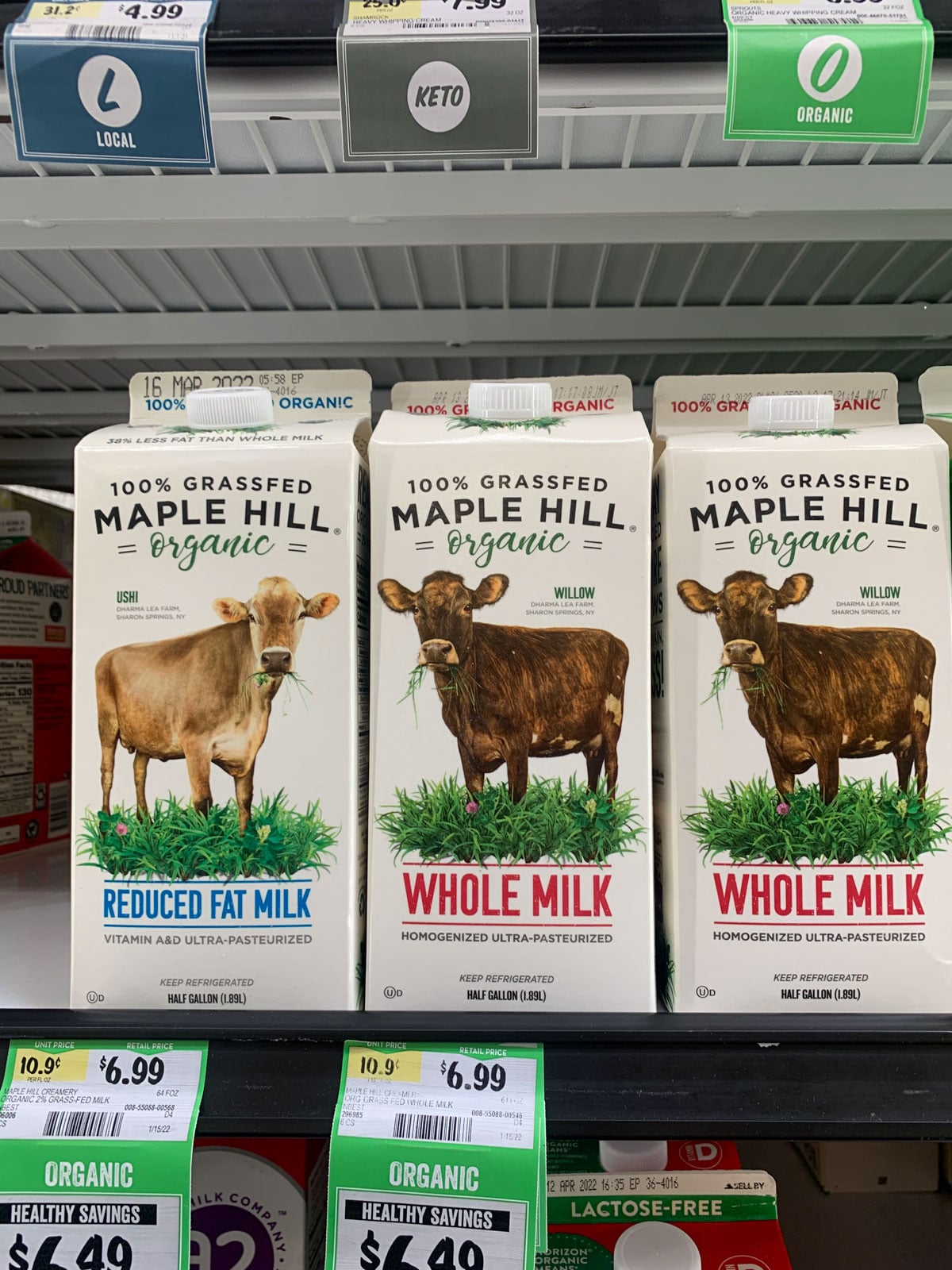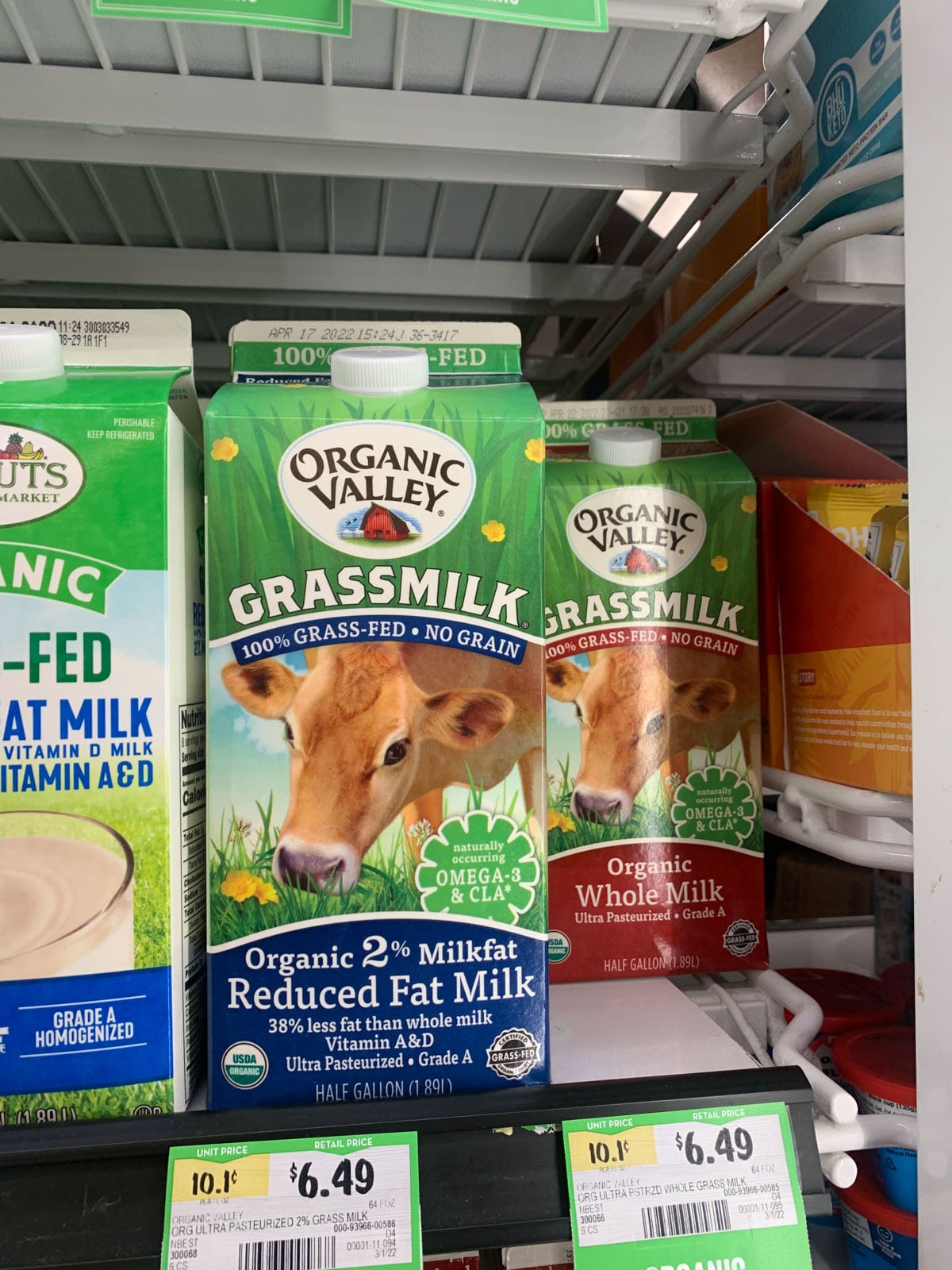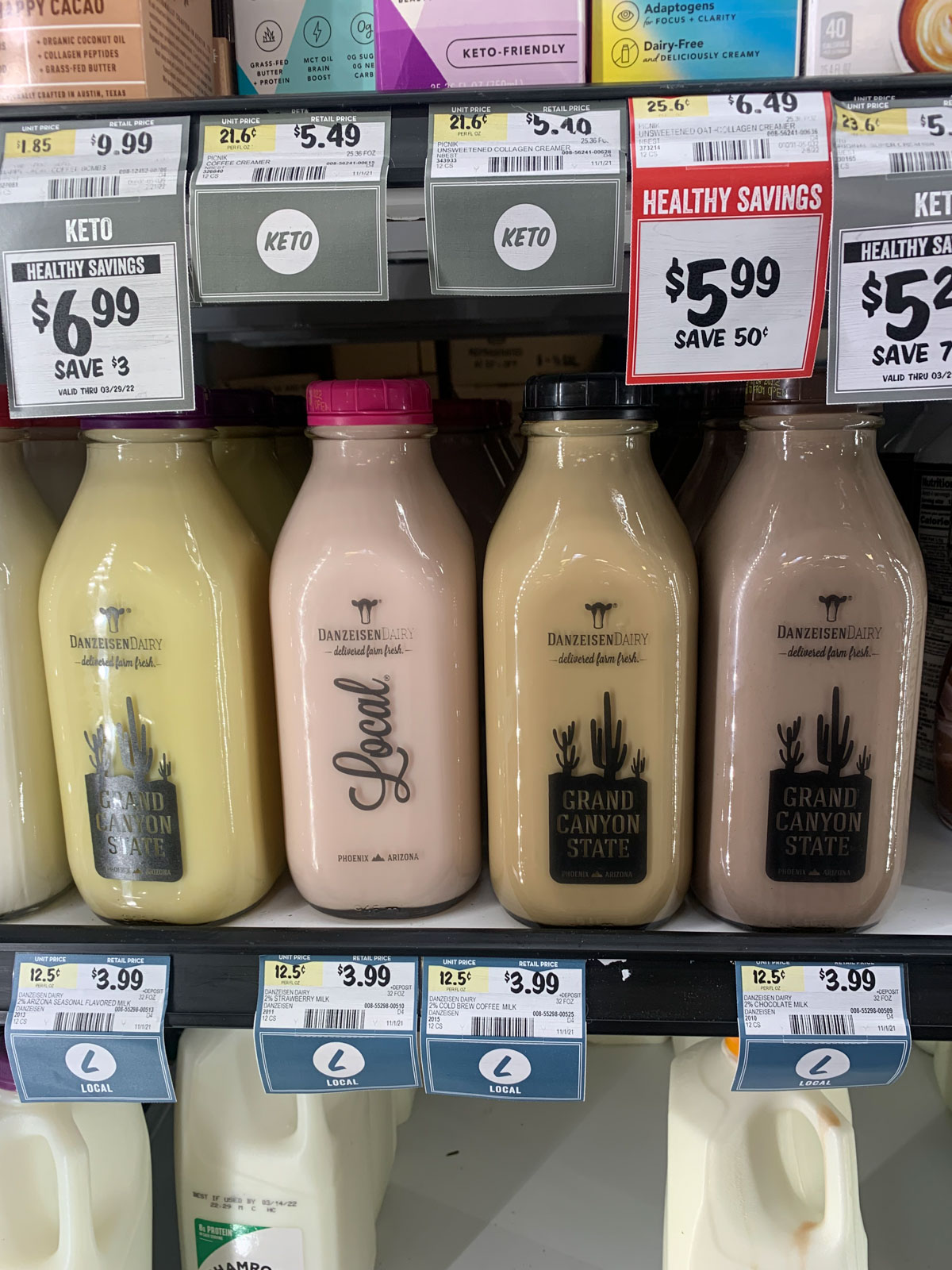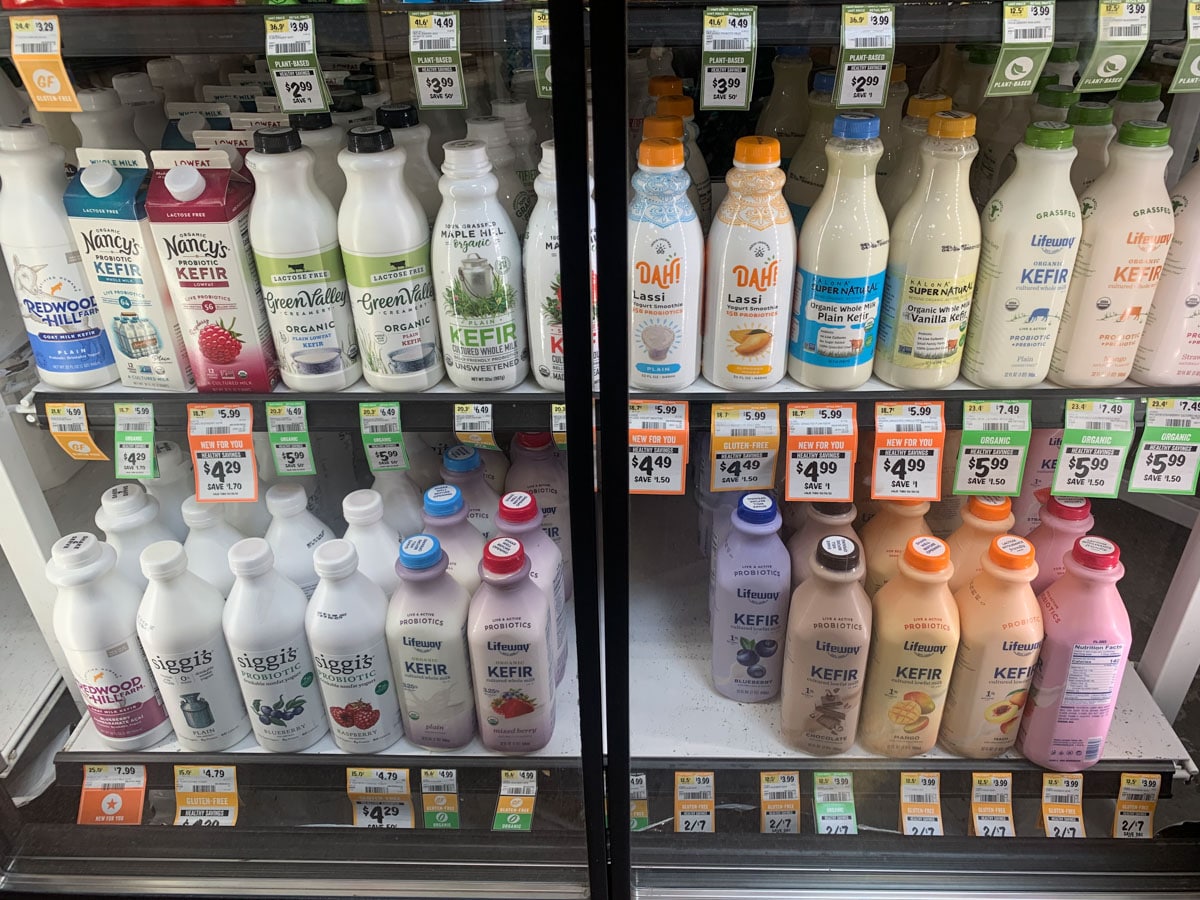Grocery Shopping 101: Dairy Section
My first Grocery Shopping 101 post on oils was a hit here and on IG. So, I’m continuing on!
I’m equal opportunity dairy and non-dairy. Some people, like myself and my son, do well with it. Some people like my other son and my husband don’t do that great. My oldest son started out intolerant and now does great with dairy. I usually consume dairy, but right now, I am not because I’m nursing a baby with MSPI. So I’m writing this article in terms of what we usually buy and eat when I’m not nursing an MSPI baby.
Your options in the milk aisle vary WILDLY. Here are some of my recommendations.
PS My plan is to cover dairy-free milk substitutes in a dedicated post! Lots to say about those too! Leave a comment with any questions about dairy or nondairy products!
Fat Content
Whole Milk – I don’t drink milk, but I buy whole milk for my son. The current recommendation is for kids over two to drink reduced-fat milk, but I respectfully disagree. Kids need the extra fat for energy and they have plenty of opportunities to get sugar, not as much for good quality fats. My kids only drink milk at mealtimes and in smoothies. I also often cook with whole or 2% milk.
2% Milk – I buy this when I have a specific recipe that calls for it, like homemade mac and cheese. It is less creamy or thick than whole milk, so it often works better in some recipes.
Nonfat Milk – We don’t buy this in my house, and I don’t typically recommend it. Furthermore, if you struggle with acne, nonfat dairy seems to have a higher correlation than other dairy products to acne.
Pasteurized vs. Raw Milk
Raw milk is milk of any type that has NOT been pasteurized before being sold in stores. Pasteurization is the process of quickly heating something to extremely high temperatures to sterilize it. Proponents of raw milk make all kinds of unsubstantiated claims about its ability to cure a wide variety of ailments.
In reality, raw milk is about one of the most dangerous things you could put in your shopping cart. Before the development of pasteurization, raw milk was responsible for millions of people becoming sick and dying of tuberculosis, scarlet fever, typhoid fever, and other diseases transmitted through raw milk. Pasteurization has prevented millions of people from becoming ill. Raw milk is outlawed in many states, but I urge you to stay clear if it’s available near you. If you don’t believe me, watch Rotten on Netflix.
I recommend you avoid raw milk products of all kinds for the safety of you and your loved ones.
Alternative Brands
A2 Milk – a short explanation of this milk brand is that they use genetically different cows from the majority of dairy cows. As a result, the protein found in their milk is slightly smaller and potentially easier to digest than milk from standard dairy cows. Mr. Hungry does seem to do better with A2 milk, so we occasionally buy it for cooking purposes.
Lactaid Milk – a BRAND has the enzyme lactase added for lactose intolerant individuals. Lactose intolerance is an issue with milk sugar metabolism, not the protein mentioned above. We don’t need this in my house so, we don’t buy it. It can be sweeter tasting than standard milk products because the sugar is predigested in it.
Fairlife – this milk is ultra-filtered to contain more protein and less sugar per cup. It comes in a variety of flavors and fat contents. It may be best for someone who is really needing to watch their carbohydrate intake.
Organic & Grassfed
Organic – There are many organic certifications, so I’m referring specifically to USDA organic. Organic milk must come for cows that have not been treated with antibiotics or given hormones. In addition, they must be fed at least 30 percent of their diet on a pasture, and the rest of the feed must be grown without chemical fertilizers, pesticides, or genetically modified seeds.”
I do typically buy organic, but more so because I prioritize grass-fed milk for my family. See below.
Grassfed – My understanding is that this term isn’t regulated. As mentioned, organic milk often comes from a cow that spends at least 30% of its time on pasture. I prefer to get 100% grass-fed milk.
Ideally, the cows producing that milk spend 100% of their time on pasture. This may not always be the case. Sometimes it might be part pasture, part grass pellets. But, the more time cows spend on pasture, the better for our environment and the more antioxidants and anti-inflammatory omega-three fatty acids their milk contains. It’s a win-win.
Locality
In Arizona, we have a couple of hometown dairy companies, including Shamrock and Danzeisen Milk, but neither offers 100% grass-fed (likely because cattle can’t graze here 100% of the time or they would die of heatstroke). So I try to steer towards those, especially Shamrock when buying dairy for cooking purposes.
What We Buy
What I buy my family:
- For drinking with meals – 100% grass-fed organic whole milk
- For cooking purposes – organic (sometimes) 2% or whole milk, ideally local
In other words, for what my son drinks on a day in and day out basis with his breakfast, lunch, and dinner, I buy the super expensive $6 carton of milk because I believe it to be the most nutritious thing I can buy him. On the flip side, I usually buy organic for cooking purposes, but not always, and I base the fat content on the intended use for the milk.
Half and Half & Heavy Cream
These contain higher amounts of fat than even whole milk. Since both toxins and nutrients are found in dairy fat, I try to prioritize 100% grass-fed organic here more than anywhere else! I often encourage my clients to wean themselves off sugary coffee creamers to one of these options instead (if they can tolerate dairy.)
Yogurt
Fat Content (nonfat, 1%, 2%, 4%, whole milk) – I base the type of fat on my intended use for the yogurt. I might buy nonfat if I plan to have it as a snack with some nuts mixed in. If I plan to eat it on its own, I might get a whole milk version. It just depends.
Organic & Grassfed – I will often pick these if what’s available fits my intended use. However, organic yogurt is not as available as milk, so I usually don’t avoid it if a yogurt product fits my nutritional needs and taste preferences but isn’t organic.
Sugar Content – The sugar content of yogurt can vary WILDLY, from 6-30 grams per cup. Most yogurt will naturally have 11-12 grams of naturally occurring lactose (also known as “milk sugar” or sugar found in milk) without adding any additional sweetener. Certain brands, like Two Good, have filtered out the naturally occurring sugar. If you have a reason to watch your carbohydrates close, this might be a good option for you.
However, it’s the added sugar you want to pay the most attention to for most people. I try to keep it minimal, but I’m not afraid to buy a flavored yogurt either. Something around 6-10 grams of total sugar per individual, a 5-ounce portion is typically what I look for. However, I may vary this depending on the intended use of the yogurt.
Plain Yogurt – just plain fermented yogurt is a well-balanced snack or recipe ingredient. I OFTEN use plain yogurt in place of mayo because it lows the calories but isn’t as tangy as greek yogurt. I also prefer whole milk plain yogurt for babies and younger toddlers, as they don’t need the extra protein but could benefit from the fat. I don’t typically eat plain yogurt, though!
Greek Yogurt – is strained to create a thicker product that’s much higher than protein than regular yogurt. I typically recommend Greek Yogurt for cooking (where the flavor applies) and for a snack to increase protein intake in children and adults.
What We Buy
What I buy my family: any and every combination from above. Yogurt is very versatile, and depending on how I’m going to consume it depends on what fat percentage I’m going to buy. I often buy plain unsweetened products, but I’ve even been known to buy the uber 30 grams of sugar stuff to make popsicles with. So it all depends on how I’m going to use it! In general, though, I do gravitate toward whole milk 100% grass-fed organic, but that by no means is a rule!
Kefir
Like yogurt, kefir is fermented and contains billions of beneficial probiotics. However, it’s thinner in consistency than yogurt, more like a drink! I love Kefir, but I don’t buy it often. It’s great in smoothies and to drink on its own. Like yogurt, sugar and fat content varies wildly, though. I do buy KJ those drinkable organic yogurts, they have more sugar than I would like, but they are healthier than many other snack options!
Cheese
You think this section would be longer, but it isn’t. There are just a few things that I look for in cheese:
- full fat – no fake reduced-fat, please
- clean ingredient list – all recognizable ingredients
- no raw milk (see above)
That’s it! I’m leaving ice cream off the list because I doubt you want my advice there! And if you do, it’s a big enough topic for its own post!
What are your questions?!?! What are your favorite products? Tell me below!









[…] Grocery Shopping 101: Dairy Section […]